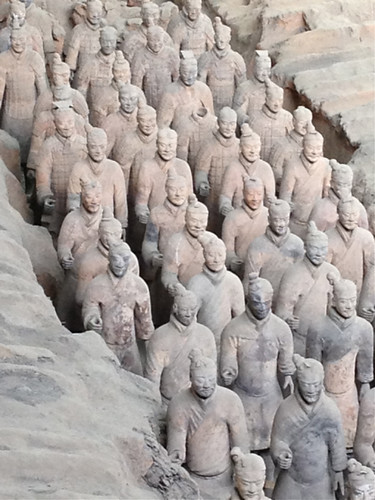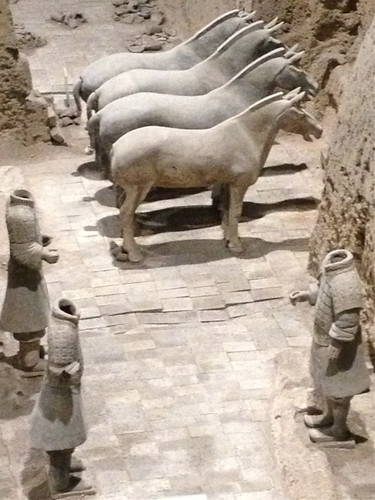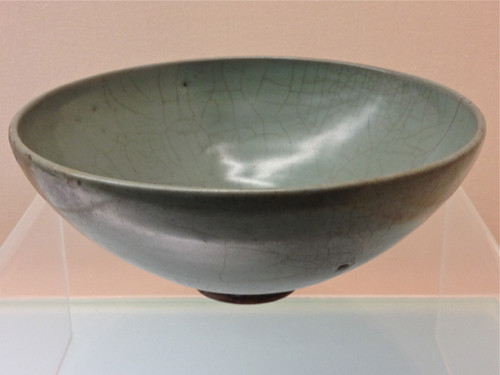Usually when I've travelled and blogged I've finished my posts about my trip with a 'five best things' post. I tried to do this for my China trip, but failed dismally. It's just too hard to distinguish and make judgments among so many diverse experiences. So, I've chosen to organise these last posts differently - around notions of time.
So, to begin - the past.
Almost everywhere you travel in China you are aware of the depth and richness of its history. Millenniums of history. More than a thousand years ago what we now call 'China' was not a nation state, but there were already centres of power and alliances and oppositions that lasted hundreds and sometimes thousands of years. Such a sense of tradition and development and sophistication must shape the identity of Chinese people in a very distinctive way. It sometimes seemed to me that the past is less visible to visitors through museums than it is in some other countries - particularly in Europe. This is understandable. As well as the discontinuity of traditions of the Chinese dynasties, in the nineteenth century many artifacts were raided by colonial powers; in the mid-twentieth century many treasures disappeared from mainland China when the Nationalists removed to Taiwan; and then finally Mao's Cultural Revolution of the nineteen sixties and seventies destroyed much of the past grandeur in its swingeing attempt to build a new nation.
But fortunately, so much of China's past can be glimpsed through major constructions that were so grand they survived centuries of depredation - the Great Wall, the Summer Palace, the Forbidden City, Suzhou's Grand Canal.

And, perhaps most grandly, the Entombed Warriors outside Xi'an. The Warriors were additionally fortunate in that they were not discovered until 1974 and consequently missed the worst destruction of the Cultural Revolution.

It's an extraordinary experience to enter the museum that houses the terracotta warriors and to glimpse the grandeur of the rule of Qin Shi Huang, the first Emperor of China. The warriors were buried near the tomb of the Emperor and their purpose was to protect the emperor in his afterlife. The life-size warriors and their horses date from 210–209 BC. I find this almost impossible to believe as the craft that's produced these figures is so perfect and somehow so modern. Maybe 'timeless' is a better word.


Even though they're not on every corner, we did visit some wonderful museums. In Xi'an there's the Shaanxi History Museum with splendid exhibits from prehistoric to current times. My favourites here are the tricoloured pottery figures from the Tang Dynasty (618-907). There's an immediacy and charming everyday quality to these pottery figures that I find irresistible - literally, as I bought a small copy of one of the ladies in the museum shop.


And then there's the grandest of the grand museums - the Shanghai Museum.

Apart from the brilliance of its collection I was impressed by the busyness of this museum. It was thronged with local people, poring over the exhibits. I can only begin to imagine how moving it must be to see the such grandeur of the cultural traditions of your country's past. The Shanghai Museum is best known for its collection of bronzes - most of them more than 3,000 years old! Many of the pieces are beautifully decorated sacrificial vessels reflecting a sophistication of social organisation and artistic forms that I find mind-boggling.

Again, I loved the Tang Dynasty tricoloured pottery figures, and I was astonished by the timelessness of the painted scrolls - many of them (somewhat ironically) on loan from US museums. But I spent most time in the ceramics section. I'm not sure how you can improve on perfect forms and perfect techniques. The bowl below is from the Song Dynasty, roughly 1,000 years ago, but its simple, elegant form transcends any sense of what's old or what's modern.

The Shanghai Museum also has a gallery displaying artifacts from its 'ethnic minorities' (their term) - the 10% of the population who are not ethnically Han Chinese. This collection includes fabrics and textiles from various non-Han groups, and, as these ethnic groups cross borders, particularly in southern China, they have similarities to textiles and craft practices in Burma, Thailand and Vietnam. The superb woven tunic below is from the Li People of southern China. Those of you who know me will know I spent lots of time in this part of the museum.

Tomorrow, a glimpse of the future.
1 comment:
I can hardly comprehend things still existing that were made so long ago, especially of such beauty and fine-ness. I am sad to say my knowledge of Chinese history, art and culture is terribly lacking. It has been great to read your posts!
Post a Comment